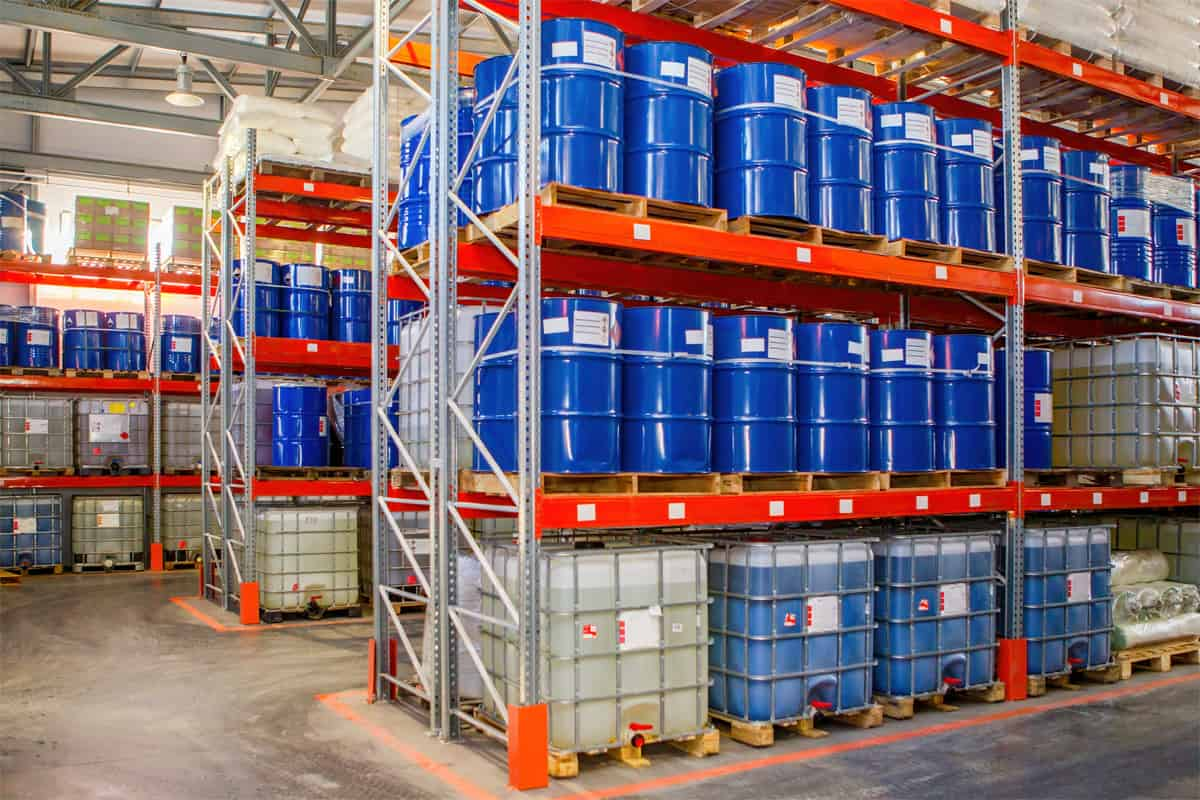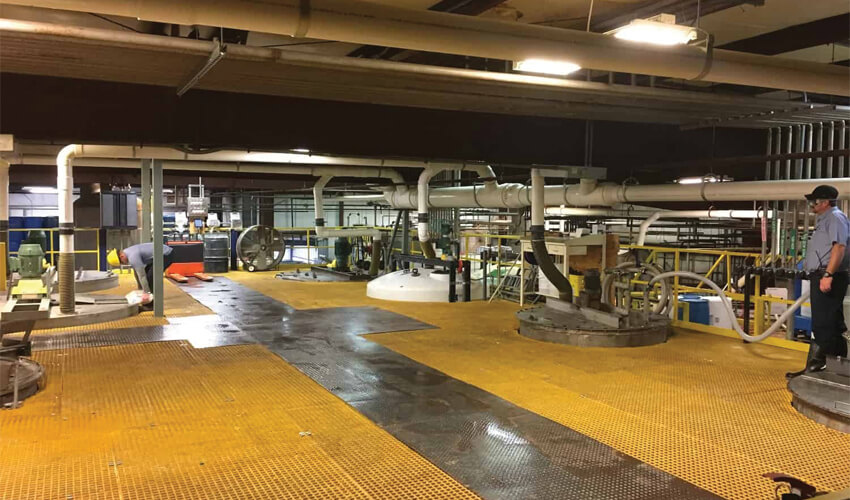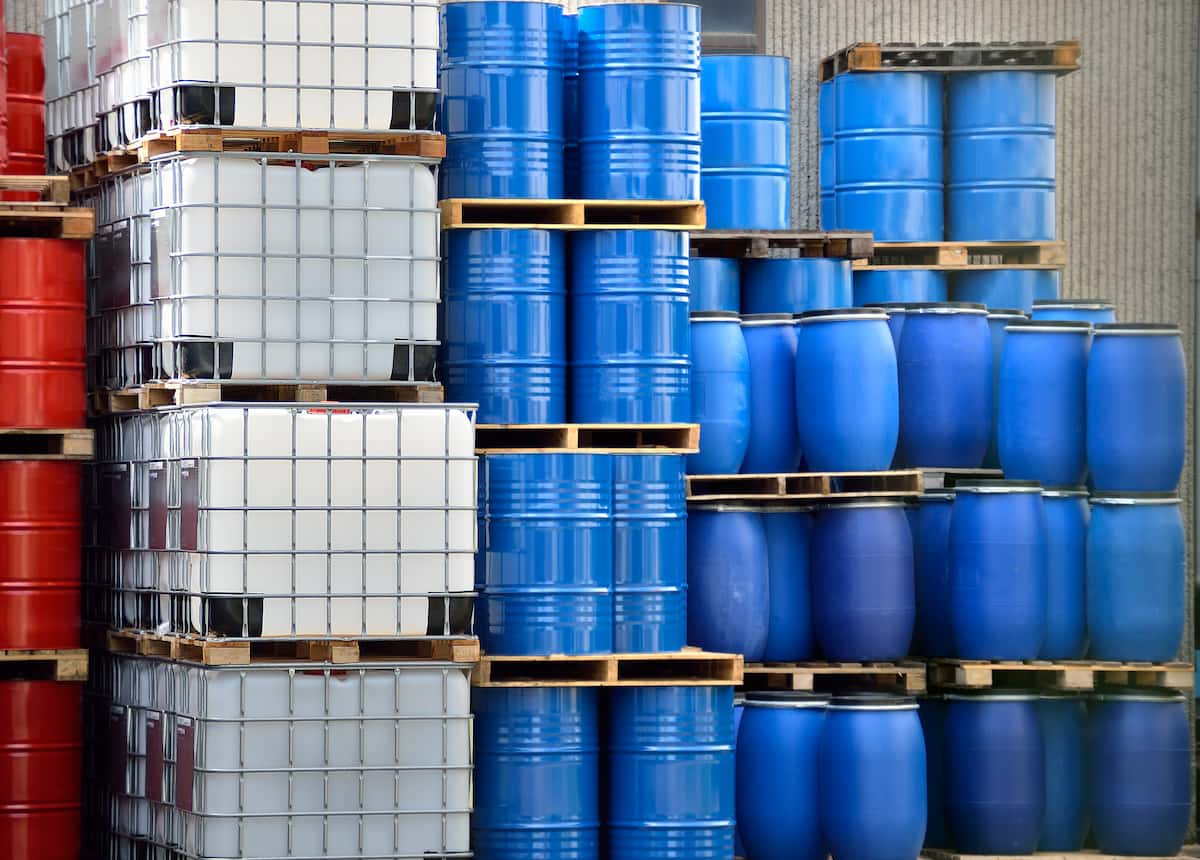
A Guide for Choosing the Best Bottles to Ship, Store & Sell Your Chemical Products
After you perfect your chemical blend, you need to find the ideal bottle for your chemical product. To do this, you'll need to become well-versed in the breadth of chemical packaging bottles available.
Then you'll need to make some key considerations. For example:
- Some compounds, like strong acids or bases, require additional safety considerations and care because of their inherent health risks.
- The material of the chemical storage bottle you choose needs to be suitable for your chemical mixture so that it doesn't degrade or become altered in any way.
- Chemical storage bottles vary in cost, so you'll need to find the one that's the most economical.
To help you choose the best bottle to ship, store and sell your chemical products, we created this quick guide. It walks you through what you should consider to make the best and safest choice.
Always Consider Safety First
When selecting a chemical bottle for storage or handling, safety is of utmost importance – and there's a lot to consider.
For example, there are many common bottle types that are designed to handle various harmful cleaning products, cleaning chemical solutions and other potentially hazardous chemicals. These bottles are designed with narrow openings that allow the user to make more precise pours, while others have wide openings to make filling easier.
But there are many other key considerations to ensure safety:
- Chemical compatibility: The material of the bottle should be compatible with the chemical it's intended to store. Incompatible materials can lead to bottle degradation, contamination of the chemical or hazardous reactions. For example, certain plastics may degrade when storing solvents, while glass might be a better option.
- Closure type & material: The cap or closure material should also be compatible with the chemical. It should provide a tight seal to prevent leaks or evaporation and protect against exposure to air or moisture.
- Pressure considerations: If the chemical produces gases or is reactive, it's important to choose a bottle designed to handle pressure changes. Some bottles are designed to vent gases to prevent buildup of internal pressure.
- Light sensitivity: If the chemical is light-sensitive, amber or opaque bottles should be used to protect the contents from light degradation.
- Temperature resistance: The bottle material should withstand the storage temperature of the chemical. Some chemicals require refrigeration, while others might need to be stored at elevated temperatures.
- Durability & impact resistance: This is especially important in a high-traffic environment or where breakage risks are high. Plastic bottles offer more resistance to breakage than glass.
- Labeling & marking: Proper labeling is crucial. Labels should be durable, legible and resistant to the chemicals and the environment in which they are stored. They should include the chemical name, concentration, hazard symbols and date of acquisition or preparation.
- Regulatory compliance: Ensure that the bottle and closure system comply with relevant regulations and standards for chemical storage, such as those set by OSHA, EPA or other local regulatory bodies.
- Size & shape: The size should be appropriate for the quantity of chemicals to be stored and safe handling and storage space should be considered. The shape of the bottle can also affect stability and ease of pouring.
- Secondary containment: Consider using secondary containment, such as a tray or bin, to contain spills or leaks.
- Child-resistant features: If the chemical is to be stored in a place accessible to children, child-resistant caps and secure storage are essential.
- Ventilation: Some chemicals require storage in a well-ventilated area to dissipate fumes.
- Disposal considerations: Plan for the safe disposal of both the chemical and the container after use, following local environmental and safety regulations.
By carefully considering these factors, you can ensure that you choose the safest bottle for your chemical storage and handling needs.
Understanding the Most Common Types of Bottles for Chemicals
The types of bottles used for shipping, storing and selling chemicals vary based on the nature of the chemicals and the required storage and shipping conditions. However, here are some of the widely used types:
- F-style bottles: These HDPE bottles come in sizes as small as 8 ounces and as large as several gallons. Their rectangular shape makes them easy to store and stack, and their durability makes them perfect for holding chemicals and cleaners. With a narrow neck and built-in handle, they can make precise pours and are easy to carry.
- Carafe bottles: Most commonly available in 16- or 32-ounce sizes, these HPDE bottles come with a 28/400 continuous thread (CT) neck finish and are great choices for acids, solvents, car care products, cleaning products and more.
- Pressure vessels: For chemicals that are gases or liquids at high pressure, these specialized containers are used for shipping and selling. They are built to withstand high pressure and are regulated for safety.
- Jerricans: Used for storing, transporting and selling larger quantities of chemicals, these durable containers are made of heavy-duty plastic and often come with a handle.
- Carboys: These are large containers for storing, shipping and dispensing bulk liquids. Made of glass or plastic, they may include a spigot and are commonly used for industrial chemicals.
- Safety coated bottles: Glass bottles with a safety coating are essential for hazardous chemicals, preventing shattering and containing spills. Ideal for storage, shipping and selling hazardous materials.
- Volumetric flasks: While primarily used in labs for preparing solutions, they can also be used for selling and shipping chemicals that require precise volumetric measurements.
- Boston round bottles: A versatile choice for storing, shipping and selling a wide range of liquids, their rounded shoulders and cylindrical shape make them stable and easy to handle. Available in glass or plastic and with screw caps for secure sealing.
Understanding the Most Common Types of Bottle Closures
The type of closure you choose for your bottle is just as important as the bottle type.
Tight-fitting caps should seal most bottles, except if your chemical compound produces gases that can build up inside such containers. In that case, you should use bottles that allow for venting. Will your buyer or user need a specialized lid to access your chemicals? Tamper-resistant or easy-dispensing caps may be the best option. Additionally, if you're looking to spray product onto a surface, there are multiple trigger closure options with different spray patterns, including jet stream or fine mist.
Here are some of the most common types of chemical bottle closures:
- Screw caps: These are the most common type of closure. They can be made of plastic or metal and are designed to screw tightly onto the threads of the bottle neck. Some screw caps come with a liner or seal to prevent leaks and protect against air or moisture ingress.
- Glass stoppers: These are used for reagent bottles and other applications where a tight, non-reactive seal is necessary. Glass stoppers are often ground to fit precisely, offering an excellent seal.
- Rubber and synthetic stoppers: Rubber stoppers are used when a tighter seal is required and for applications where a non-reactive closure is necessary. They're often used in conjunction with glass bottles for storing sensitive chemicals.
- Cork stoppers: Although less common in chemical storage due to their porosity, cork stoppers are sometimes used for storing certain types of chemicals. They're not suitable for volatile or highly reactive substances.
- Tamper-evident caps: These caps provide an extra level of security by showing whether a bottle has been opened. They're often used in applications where contamination or unauthorized access is a concern.
- Child-resistant caps: These caps require a specific mechanism to open, making them ideal for households or environments where children may be present.
- Septa and cap liners: For bottles used in chromatography or other sensitive analytical methods, caps may have a septum – a pierceable liner that allows syringe access without removing the cap.
- Dispensing caps: These include caps with built-in droppers, pipettes or pumps for easy dispensing of the chemical in controlled quantities.
Each closure type offers different levels of chemical compatibility, air tightness and ease of use, so the choice depends on the specific requirements of the chemical being stored and the safety protocols in place.
Chemical Bottle Materials
The most common materials used for bottles to store, ship or sell chemicals are chosen based on their chemical resistance, durability and safety features. Here are the common materials used:
Glasses
- Borosilicate glass: This type of glass is highly resistant to thermal shock and chemical corrosion and ideal for acidic, basic and solvent-based chemicals. It's commonly used in laboratories and for high-purity chemicals.
- Soda-lime glass: This glass type is less resistant to chemicals and thermal shock than borosilicate glass, but it is more economical. It's also suitable for less reactive substances.
- Amber glass: Used for light-sensitive chemicals, amber glass filters out ultraviolet and blue light.
Plastics
- High-Density Polyethylene (HDPE): Popular for its chemical resistance, durability and versatility, HDPE is used for a wide range of chemicals, including acids, bases and solvents.
- Polyethylene Terephthalate (PET): Known for its clarity and strength, PET is commonly used for consumer products. It's also the right choice for oils, alcohols and non-solvent-based chemicals.
- Polypropylene (PP): PP offers excellent chemical resistance and can withstand higher temperatures. It's used for containers that need to be autoclaved.
- Low-density polyethylene (LDPE): More flexible than HDPE, LDPE is used for squeeze bottles and containers that require easy dispensing.
- Fluorinated polyethylene/polypropylene: This type of plastic is used to enhance barrier properties and chemical resistance, particularly against solvents and hydrocarbons.
Metals
- Stainless steel: Chosen for its durability and high resistance to corrosion and heat, stainless steel is used for highly corrosive or reactive chemicals, especially in industrial settings.
- Aluminum: Lightweight and corrosion-resistant, aluminum is used for specific chemicals that require light protection and resistance to rust. Bottles made from aluminum are lightweight, sturdy, corrosion-resistant and 100% recyclable. These bottles are perfect for long-term storage and shipping chemicals that can be easily contaminated, such as pesticides.
Composite materials
These include combinations like plastic-coated glass or multi-layer plastics, which provide the benefits of different materials, such as enhanced durability or chemical resistance.
The case for plastic bottles in chemical storage & handling
Unlike glass, plastic chemical bottles are lightweight and shatter-resistant, which comes in handy when they're shipped. They're made from either high-density or low-density plastic and all plastic bottles identify their origin materials via a resin identification code marked on their base.
Some plastic chemical bottles are stackable with an interlocking lid and base configurations to make storage easier and more convenient. You can find a seemingly endless selection of plastic bottle configurations, from tightly sealed to vented tops that allow gases to escape.
HDPE bottles with a barrier
If your chemical compound contains hydrocarbons or aromatic solvents, you can still consider using HDPE bottles, but they require a barrier. Fluoride-treated HDPE bottles provide that extra protection by exposing the bottles to fluorine gas. These specialized bottles best contain chemical compounds such as pesticides, herbicides, photographic chemicals, cleaning products and more.
How are LDPE bottles different from HDPE bottles?
LDPE bottles allow users to squeeze the chemical compound out of the container as they're more elastic than HDPE. LDPE bottles are also more translucent and much less rigid than those made from HDPE plastic. However, they're less resistant to chemical contents and more costly.
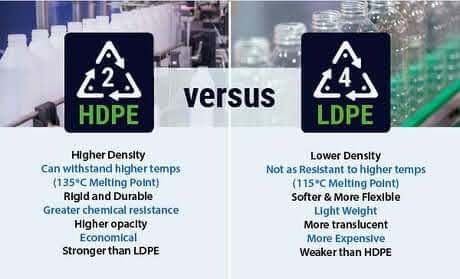
Is PET a viable option for you?
PET bottles are the plastic bottles of choice for beverages and food packaging due to their durability, high shatter resistance, transparency and light weight. PET provides an oil barrier that helps protect the plastic from any chemicals being stored inside. The composition of PET bottles can also be a viable option for many chemical compounds outside of acetones and ketones.
Need rigidity? Consider polypropylene bottles
When you imagine a typical screw cap jar, you're thinking of a bottle made from polypropylene plastic. It's more rigid than polyethylene, resistant to the chemicals inside and is compatible with a variety of lab agents such as most acids, bases, alcohols, aldehydes, esters and aliphatic hydrocarbons.
Why are PVC bottles declining in usage?
Polyvinyl chloride, or PVC, bottles are chemically resistant but vulnerable to some solvents. PVC is very dense, affordable, rigid, durable and strong. However, it will distort and become malleable at around 160 °F (71 °C), making it less than ideal in some storage situations. But this also means that it can be liquified for injection molding. In recent years, concerns regarding potential health risks have arisen, making it less attractive as an option.
Teflon-coated bottles
The non-stick nature of polytetrafluoroethylene (PTFE), commonly known as Teflon, along with its resistance to powerful acids and bases, makes it a perfect coating for storage containers that demand more protective containers.
Bottle Closure Materials
The closure materials used for chemical bottles are selected based on their chemical compatibility, durability and the specific storage requirements of the chemicals. Here are some of the most common types of closure materials:
- Polyethylene (PE): Polyethylene closures, including HDPE and low-density polyethylene (LDPE), are widely used due to their good chemical resistance, especially against acids, alcohols and bases. They're also impact-resistant and flexible.
- Polypropylene (PP): Polypropylene caps are known for their excellent chemical resistance and are often used for containers that store corrosive chemicals. They can withstand higher temperatures than polyethylene, making them suitable for autoclaving.
- Phenolic (Bakelite): Phenolic caps are typically used with glass bottles and are known for their high heat resistance and durability. They often have a liner like PTFE (polytetrafluoroethylene) to provide an inert barrier between the cap and the chemical.
- Teflon (PTFE): Teflon is used for liners and seals in bottle caps. It has excellent chemical resistance, including resistance to solvents, and is non-reactive.
- Silicone: Silicone liners or seals are used for their flexibility and chemical stability. They provide a good seal and are often used in pharmaceutical and biotech applications.
- Aluminum: Aluminum caps are sometimes used for glass bottles, especially in laboratory settings. They provide a good seal and are resistant to many chemicals, but they can corrode with certain substances.
- Stainless steel: Used in more specialized applications, stainless steel caps offer high resistance to corrosion and heat. They're often used in high-purity environments or with highly reactive chemicals.
- Rubber and synthetic elastomers: Rubber (natural or synthetic) is used in stoppers and seals. It's important to match the type of rubber to the chemical stored, as some chemicals can degrade certain rubbers.
Each material has its advantages and limitations, and the choice depends on the chemical properties of the contents, the required seal quality and environmental factors like temperature and UV exposure. Compatibility with the chemical being stored is the most critical factor to prevent degradation of the cap and contamination of the contents.
Understanding the Best Chemical Bottle Storage Conditions
Here are a few do’s and don’ts to maximize the shelf life and efficacy of your chemical compounds.
Do:
- Choose a controlled environment for storage
- Provide a dark, dry space without moisture (ideal storage temperatures range from 36°–85°F [2°–29°C]; your specific chemical compound may vary)
- Replace the caps right after use
- Try to turn inventory within 12 months to ensure total chemical efficacy
Don't:
- Leave your chemical storage bottles out while transporting
- Let them sit directly in the sun
- Risk contamination by switching caps or placing caps on an unclean surface
Reach Out To Find the Best Bottle for Your Chemical Blend
Trust the industry experts at Royal Chemical to help you store and handle your chemicals successfully and safely.
Reach out to schedule a free consultation today to find the best bottles for your blends.
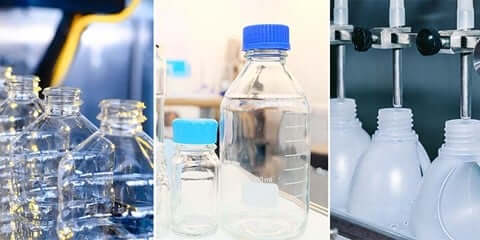
Talk to an Expert
Streamline Your Chemical Manufacturing Process
Royal Chemical’s expertise in blending, packaging and shipping can save you time, reduce costs and deliver consistent results.













